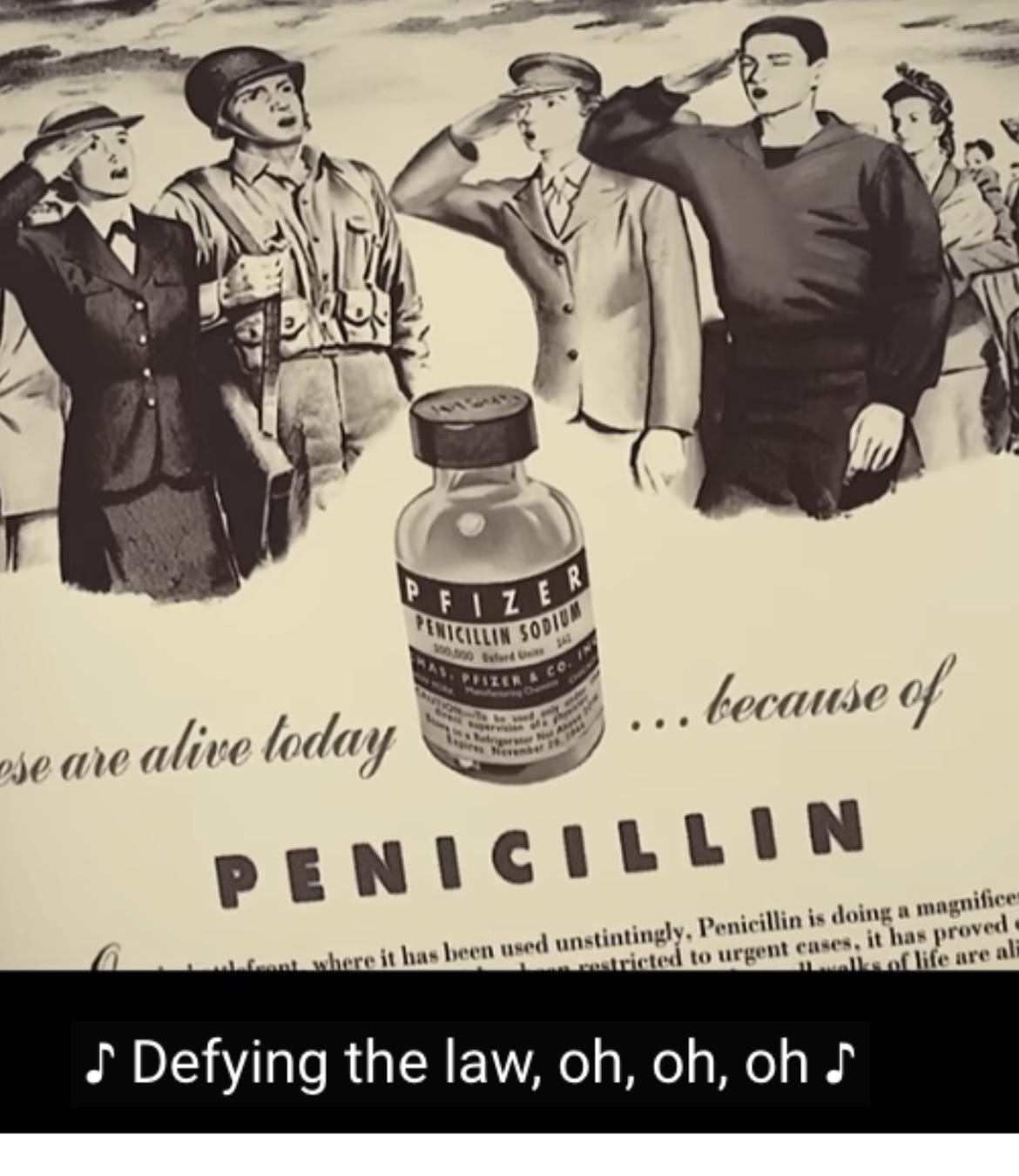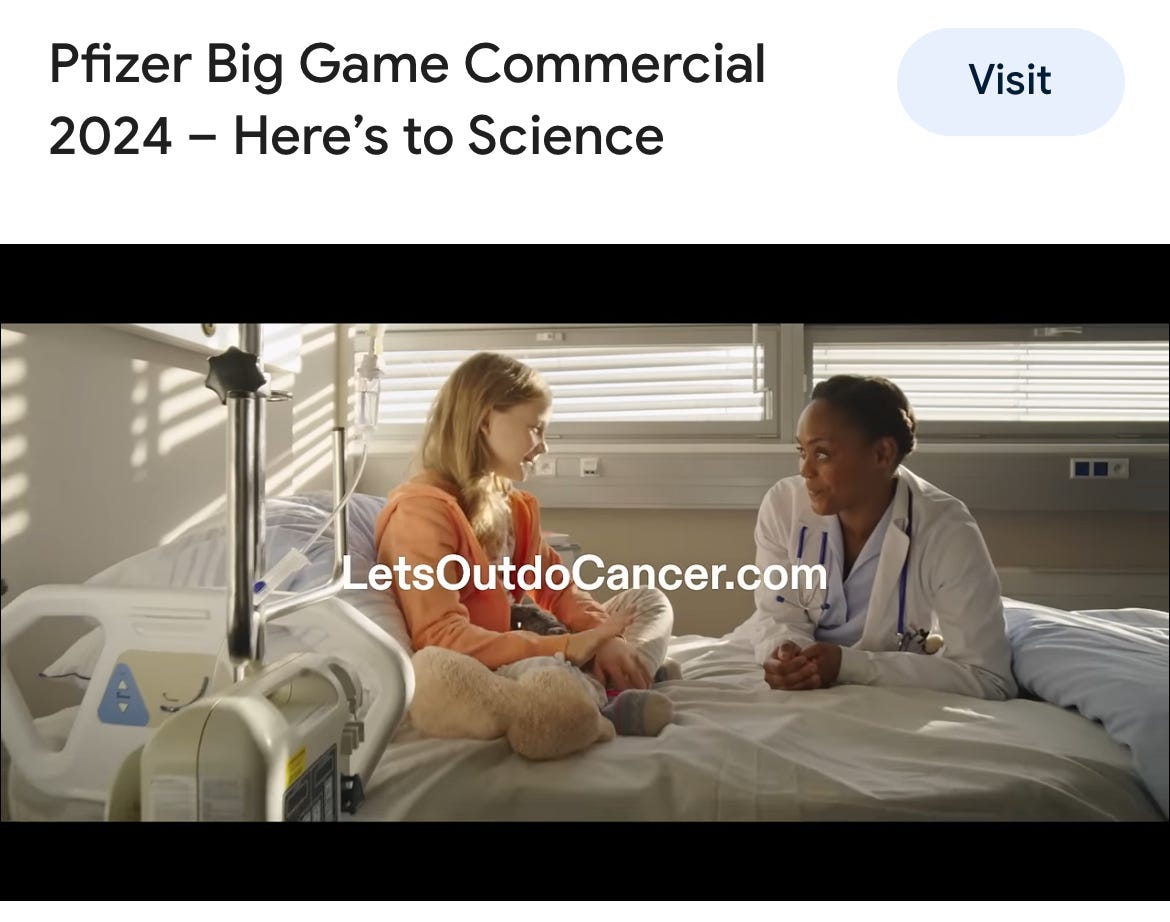![]()

by Alex Berenson
Hey, didya see that Super Bowl?
The more things change… and I don’t mean the Chiefs winning again.
When I covered Big Pharma for the New York Times during the aughts, the two most important companies I wrote about were Merck and Pfizer.
Merck had problems, including its push of the risky painkiller Vioxx. But it had introduced the first statin and made other big breakthroughs. It was the industry’s scientific leader.
Pfizer was second-rate, scientifically.
But from its Manhattan headquarters, it excelled at marketing. Its army of famously hot sales reps spread baksheesh in doctor’s offices, from lunches to trips to ski towns – where physicians could learn about up-to-date treatments, of course. The seminars were scheduled not to cut into peak ski time.
Pfizer’s favorite medicines were me-too drugs. Let another company take the risks. Pfizer would find, or buy, a similar compound, and use marketing to pull ahead. So it did with Lipitor, a statin that became the world’s top selling drug for almost a decade.
—
Pfizer’s efforts at actual scientific discoveries were more problematic.
In 1996, it tested an antibiotic called Trovan during a meningitis epidemic in Nigeria. Eleven children died. The Washington Post later published an investigation about the trial that began, “By the time word of the little girl’s death reached the United States, her name had been replaced by numerals: No. 6587-0069.”
Around the same time, John le Carre wrote a novel called “The Constant Gardner,” about an evil drug company that killed African kids in an unethical trial. Le Carre insisted his book wasn’t based on Trovan. Kinda. His afterword read: “In these dog days when lawyers rule the universe, I have to persist with these disclaimers…”
No matter, Pfizer later settled a suit over Trovan for $75 million, or about two days of peak Lipitor sales. (Full disclosure: I am suing Pfizer’s chairman Dr. Albert Bourla and board member Dr. Scott Gottlieb in Berenson v Biden for their roles in the 2021 conspiracy to violate my First Amendment rights and force Twitter to ban me.)

—
Pfizer had a few other, umm, legal issues too, back in the day.
The New York Times, May 14, 2004:
Pfizer, the world’s largest pharmaceutical company, pleaded guilty and agreed to pay $430 million to resolve criminal and civil charges that it paid doctors to prescribe its epilepsy drug, Neurontin, to patients with ailments that the drug was not federally approved to treat.
Bloomberg News, April 3, 2007:
Pfizer Inc. agreed to pay $34.7 million in fines to settle Justice Department allegations that it improperly promoted the human growth hormone product Genotropin.
And of course the big one, the granddaddy of ‘em all (though not the last),
The Wall Street Journal, Sep. 2, 2009:
Pfizer Makes History With $2.3B Fraud Settlement
…the deal represents the largest health-care fraud settlement in [Dept. of Justice] history.
Yay! Who doesn’t like setting records?
So we come to Sunday night.
Super Bowl 58 had been a snooze – fumbles, punts, more fumbles, it reminded me of nothing so much as a Jets game – but it was just getting good.
Then it went to commercial: a library… a portrait of Isaac Newton… an anatomy textbook…
Huh, I thought. This is weird –
Hey, wait, isn’t that a portrait of Karl Christian Friedrich “Charles” Pfizer – 19th century German-born chemist, founder of the company that bears his name?
So a Pfizer ad?
Followed by lots more scientists. Including Einstein! And Galileo! And… Katalin Kariko, the University of Pennsylvania scientist who helped make mRNA Covid jabs possible, by figuring out how to modify mRNA so it could be injected and used to hijack our cellular machiner. (Doesn’t necessarily sound like a good idea when I put it that way, huh? A cool idea, but not a good idea.)
(A still from the Super Bowl ad. The words at the bottom are from the Queen song “Don’t Stop Me Now,” the track on the ad. Didn’t anyone see the irony?)

Then, after 50 seconds of science-y science set to Freddie Mercury, the ad makes a quick and awkward pivot to a girl in a hospital bed, with the strange phrase “LetsOutdocancer.com” slapped across the screen.

The ad ends as the girl walks out of the hospital. Exactly what role Pfizer or its medicines played in her cure is left to the viewer’s imagination. This isn’t about products, people! This is about feels. And science. And how science makes us feel!
Super Bowl spots this year cost a cool $7 million for 30 seconds (arguably a bargain, given that the biggest audience since the moon landing watched Sunday’s game). This ad ran a full minute, so $14 million. Plus production and licensing costs.
And, again, the ad doesn’t mention any specific products, except penicillin, which is not exactly a big Pfizer product these days. The reference to Katalin Kariko flicks at the Covid jabs. But I would guess only 5 to 10 percent of Americans have any idea who she is. Including her is a way to mention the mRNAs without talking about them.
So what was Pfizer doing? Why blow $14 million-plus on what is essentially a generic corporate image campaign? Where’s the return on investment?
I have thoughts.


Victims and their Families should be allowed to Sue Pfizer for everything its worth